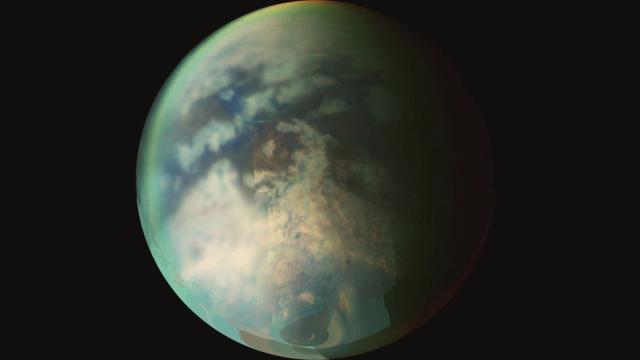Scientists have found evidence of seasons on the surface of Saturn’s moon Titan, thanks to observations akin to sunlight reflecting off of wet pavement.
We already knew that Titan experienced methane rainstorms on its south pole, making it the only astronomical object we know of where it rains onto the surface. The moon tilts on its axis, but as its position changed and as clouds refused to form over its north pole, scientists wondered if and when they’d see evidence of changing seasons. Cassini’s observations of the long-overdue rain finally came in on June 7, 2016, signalling the start of Titan’s north polar summer.
“Everyone was confused as to why it wasn’t happening,” Rajani Dhingra, a doctoral student in physics at the University of Idaho, told Gizmodo. “This tells us that not only does it happen, but that it was delayed.”
Seasons should work similarly on Titan as they do on Earth, since both bodies tilt on their rotational axes. The hemisphere that faces the Sun experiences “summer,” while the hemisphere tilted away from the Sun experiences “winter.” When the Cassini mission arrived at Saturn in 2004, Titan’s southern hemisphere was experiencing summer, and the spacecraft recorded evidence of rainfall at the moon’s south polar region.
There are approximately 14 years between Titan’s solstices, or the times each pole receives the most sunlight. (On Earth, of course, the solstices are just six months apart.) So, as Titan’s southern summer ended and its northern summer began, researchers expected to spot clouds and rain in the northern hemisphere. But the rain wouldn’t come.
Today, scientists report the results from an analysis of data coming from a spectrometer on Cassini: a distinct bright spot covering an area the size of Pennsylvania, or 120,000 square kilometers, but only on certain days. The researchers hypothesized that they’d spotted liquid filling in the cracks on the moon’s surface, causing it to reflect more sunlight. In other words, they saw a broad damp region on the surface, like a big swath of wet pavement — the result of rain.
It’s important to note that there are other hypotheses as to what may have caused the bright spot, such as fog, according to the paper published in Geophysical Research Letters.
The researchers felt, based on their analysis, that surface wetting from presumed rain was the most likely explanation, though, which would make this the first observation of rain on Titan’s north pole. This the “wet footpath effect” could now serve as a new way to observe this rain.
And now that the researchers have actually spotted evidence of rain, they hope to understand why it was so delayed. “This is a big piece of the puzzle,” Dhingra told Gizmodo. “This observation will help our understanding of what happened.” Perhaps it will help researchers understand Titan’s geology via the roughness of its surface, too.
This result is yet another example of important posthumous science from the Cassini mission, which ended in September 2017 when the probe plunged into Saturn. But scientists hope that more science will come soon—Saturn is presently probe-less, but NASA has funded a project that would send a quadcopter to Titan’s surface.
But working on Titan science has been a dream-come-true for Dhingra. She said: “It definitely makes coming to work every day meaningful.”
